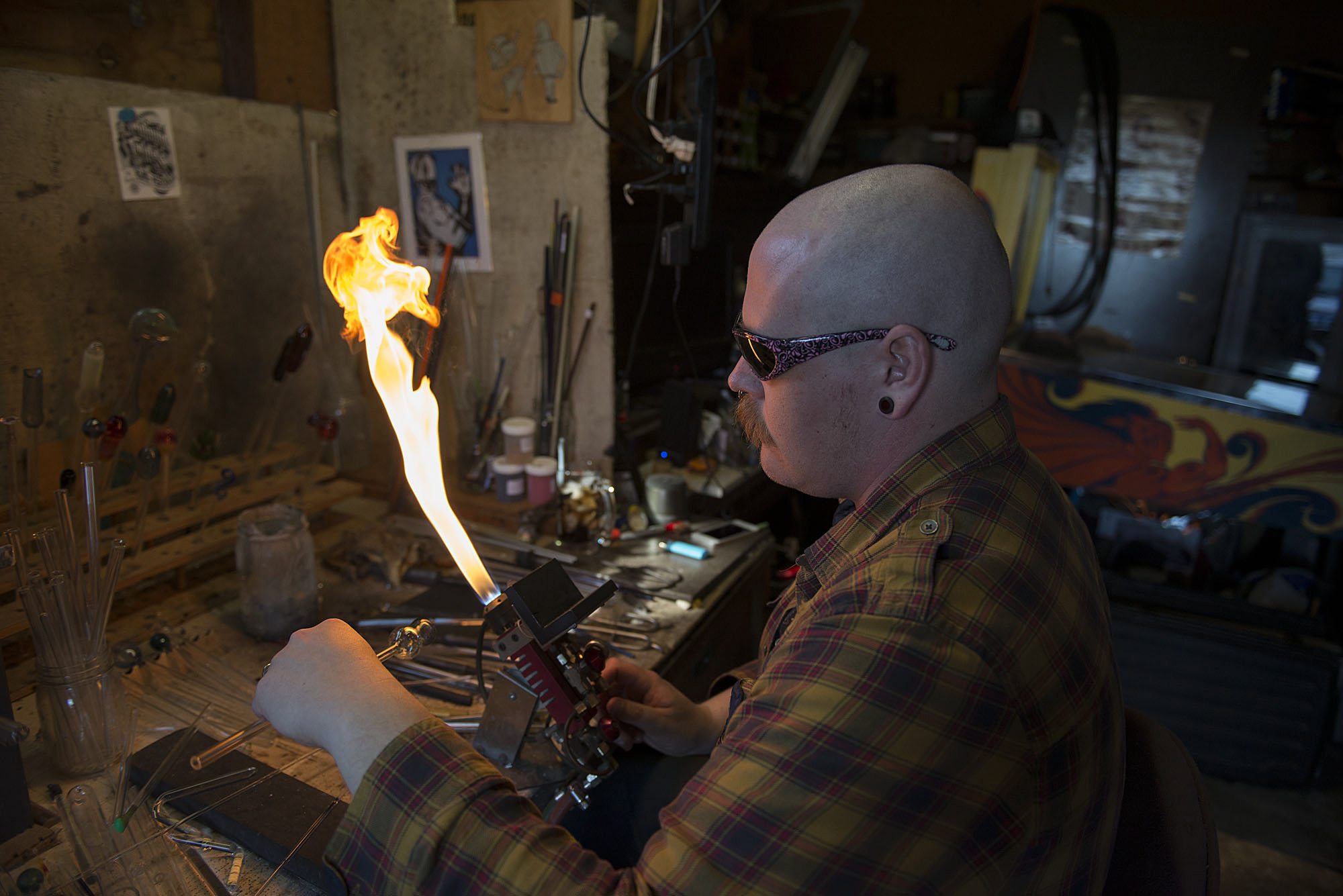When Portland art glass manufacturers Uroboros Glass and Bullseye Glass halted their production of some of their products over public concerns about heavy-metals pollution, the move triggered shock from art-glass manufacturers, vendors and artists locally and around the world.
“People worldwide are freaking out,” said Portland fused-glass artist Kevin Kanyo. “Artists in the UK, Australia and New Zealand pretty much rely on Bullseye. That’s their source, for their supply.”
In Vancouver, Sheri Spurlock and her husband, Ted Mumford, own Melt, a glass-art supply business with a modest storefront and strong online retail presence. The store is filled with a catalog of colored glass tiles similar to that of a record shop. Its walls are lined with glass rods in a variety of hues, but the section that holds reds, oranges and yellows are conspicuously empty.
Many of Sperlock’s products come from Bullseye Glass and Uroboros, which are the two main manufacturers of fuse glass, a soft type of glass that artists use to make decorative plates and tiles. Because of Melt’s speciality offerings, it frequently fields orders from as far away as Sweden, Australia and New Zealand.
When the glassmakers ended production, Spurlock immediately bought what she could and sold it almost as fast. Now, she and other glass artists are watching and waiting.
“At first, I saw more demand, but now people are making do with the colors they have,” she said.
Spurlock and many others who make their living off glass arts are worried about the future of the industry if Bullseye and Uroboros don’t resume production. “It will create a huge vacuum worldwide because no one else makes this stuff — it’s very specialized,” she said.
At the time they cut production, Uroboros and Bullseye were operating within their state of Oregon air quality permits. But after state and federal agencies found heavy-metals pollution around their facilities, the two companies voluntarily slashed production indefinitely of certain colors that require cadmium, chromium and arsenic. The companies would not meet Washington’s more stringent air pollution standards. Some local buyers say it’s unfair that the companies, under public and political pressure, have had to curtail production even though they violated no laws.
Battle Ground fused-glass artist Ann Cavanaugh said her color pallet was hit hard by the reduced production. While she once bought in bulk directly from Bullseye and Uroboros, now she can’t get even a modest order filled. Artists now are sharing supplies and being more conservative with what they have.
“It’s led me to be a lot more careful and not throw away powder that’s landed on the table, but to use sheets of paper to recover it,” she said.
Cavanaugh also is trying different ranges of colors and trying to develop techniques that require less glass while still offering the same visual depth. However, many of those available colors lack the vibrancy of the cadmium, chromium glasses.
“It’s like we’ve been through the Renaissance and now we’re going to go through the Dark Ages where everything is dull and drab,” she said.
Like many artists, Cavanaugh teaches classes to supplement her income. But worries that whatever pollution controls are put in place at the manufacturers will put an already expensive art form out of reach for hobbyists.
“I worry that if the materials go up, the classes and materials won’t be accessible because they’ll be priced out of a hobbyist’s range,” she said.
The government’s crackdown on Uroboros and Bullseye has had a ripple effect on other manufacturers as well. Although they’re not being scrutinized by the state, Portland-based hard-glass manufacturers Glass Alchemy and Northstar Glassworks halted production of reds, yellows and orange cadmium glasses shortly after Uroboros and Bullseye.
But Sarah Jenkins, who handles materials purchasing for her artist husband, Jamie, saw the stoppage coming and bought as much of the cadmium-colored glasses as she could.
Now, she said, “people online are selling it online for three times what they paid for it.” For example, two pounds of lemon-drop yellow are selling for up to $600 when it would normally sell for $200.
For now, the Jenkinses are watching and waiting. They’re not using the cadmium-based colors until things calm down. How much they dip into their supply depends on what the manufacturers do next.
“They say it’s temporarily discontinued for four to six weeks, but now it’s been three of those weeks and there’s no word of it coming back,” Sarah Jenkins said.




